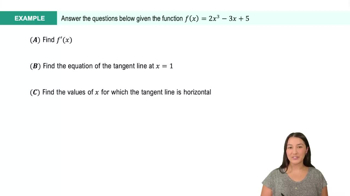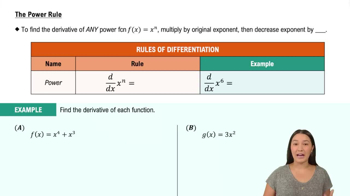Table of contents
- 0. Functions7h 52m
- Introduction to Functions16m
- Piecewise Functions10m
- Properties of Functions9m
- Common Functions1h 8m
- Transformations5m
- Combining Functions27m
- Exponent rules32m
- Exponential Functions28m
- Logarithmic Functions24m
- Properties of Logarithms34m
- Exponential & Logarithmic Equations35m
- Introduction to Trigonometric Functions38m
- Graphs of Trigonometric Functions44m
- Trigonometric Identities47m
- Inverse Trigonometric Functions48m
- 1. Limits and Continuity2h 2m
- 2. Intro to Derivatives1h 33m
- 3. Techniques of Differentiation3h 18m
- 4. Applications of Derivatives2h 38m
- 5. Graphical Applications of Derivatives6h 2m
- 6. Derivatives of Inverse, Exponential, & Logarithmic Functions2h 37m
- 7. Antiderivatives & Indefinite Integrals1h 26m
- 8. Definite Integrals4h 44m
- 9. Graphical Applications of Integrals2h 27m
- 10. Physics Applications of Integrals 2h 22m
3. Techniques of Differentiation
Basic Rules of Differentiation
Problem 84b
Textbook Question
The following limits represent f'(a) for some function f and some real number a.
b. Evaluate the limit by computing f'(a).
lim x🠂1 x¹⁰⁰-1 / x-1
 Verified step by step guidance
Verified step by step guidance1
Step 1: Recognize that the given limit represents the derivative of a function at a point. Specifically, it is the definition of the derivative f'(a) at a = 1 for the function f(x) = x^{100}.
Step 2: Recall the definition of the derivative: f'(a) = \lim_{x \to a} \frac{f(x) - f(a)}{x - a}. In this case, f(x) = x^{100} and a = 1, so f(1) = 1^{100} = 1.
Step 3: Substitute f(x) = x^{100} and f(1) = 1 into the derivative definition: \lim_{x \to 1} \frac{x^{100} - 1}{x - 1}.
Step 4: Notice that the expression \frac{x^{100} - 1}{x - 1} is an indeterminate form 0/0 as x approaches 1. To resolve this, apply L'Hôpital's Rule, which states that if \lim_{x \to c} \frac{f(x)}{g(x)} = \frac{0}{0}, then \lim_{x \to c} \frac{f(x)}{g(x)} = \lim_{x \to c} \frac{f'(x)}{g'(x)}.
Step 5: Differentiate the numerator and the denominator separately: f'(x) = 100x^{99} and g'(x) = 1. Then, apply L'Hôpital's Rule: \lim_{x \to 1} \frac{100x^{99}}{1}. Evaluate this limit by substituting x = 1.
 Verified video answer for a similar problem:
Verified video answer for a similar problem:This video solution was recommended by our tutors as helpful for the problem above
Video duration:
4mPlay a video:
Was this helpful?
Key Concepts
Here are the essential concepts you must grasp in order to answer the question correctly.
Limits
A limit is a fundamental concept in calculus that describes the behavior of a function as its input approaches a certain value. It helps in understanding how functions behave near specific points, which is crucial for defining derivatives and integrals. In this context, evaluating the limit as x approaches 1 allows us to analyze the function's behavior at that point.
Recommended video:

One-Sided Limits
Derivatives
The derivative of a function at a point measures the rate at which the function's value changes as its input changes. It is defined as the limit of the average rate of change of the function over an interval as the interval approaches zero. In this question, f'(a) represents the derivative of the function f at the point a, which can be computed using the limit provided.
Recommended video:

Derivatives
L'Hôpital's Rule
L'Hôpital's Rule is a method for evaluating limits that result in indeterminate forms, such as 0/0 or ∞/∞. It states that if the limit of f(x)/g(x) leads to an indeterminate form, the limit can be found by taking the derivative of the numerator and the derivative of the denominator. This rule is particularly useful in the given limit problem, where direct substitution leads to an indeterminate form.
Recommended video:
Guided course

Power Rules

 3:59m
3:59mWatch next
Master Derivatives of Linear Functions with a bite sized video explanation from Callie
Start learningRelated Videos
Related Practice







